When will we see the second rate cut in the current monetary cycle in India? Those who were looking for a clue to this in the Reserve Bank of India’s (RBI) bimonthly monetary policy review on Tuesday, if not a cut itself, have been disappointed. RBI has not cut the rate and there is no hint either of going in for yet another rate cut outside the policy review—something the central bank did on 15 January.
Frankly, nothing has changed between 15 January and now and no fresh set of data has come in which could have prompted RBI to do an encore on Tuesday on the rate front. It has, however, cut the floor for banks’ bond holding, or the so-called statutory liquidity ratio (SLR), by half a percentage point to 21.5%. This will free money for banks to lend to corporations. At this point, it is nothing but a symbolic gesture by the central bank and one should not read too much into it as bank credit growth is at a historic low. Commercial banks are not too excited to lend for fear of piling up bad assets even as corporations are not aggressively pushing for fresh loans as their plans for investments remain tentative. This will also keep the government on its toes; as the mandate to buy bonds reduces for banks, the government must rein in the fiscal deficit and borrow less from the market.
Bond prices dropped and yields rose after RBI released its policy as the central bank has not given any fresh guidance. The Tuesday policy document is nothing but a reiteration of what it had said on 15 January while announcing a quarter percentage point rate cut. At that time, it had said, “key to further easing are data that confirm continuing disinflationary pressures. Also critical would be sustained high quality fiscal consolidation…” Given that there have been no substantial new developments on the disinflationary process or on the fiscal outlook since 15 January, it was a given that RBI would await them and maintain its easy money policy stance.
The next set of inflation data will be released mid-February. Most analysts are expecting January retail inflation in the range of 5.4% and 5.6%, higher than 5% recorded in December and 4.4% in November. Since RBI is giving equal importance to the trajectory of the disinflationary process as well as fiscal consolidation, in the most optimistic scenario the next rate cut can happen around mid-March. The Union budget will be presented on 28 February and the February inflation data will be released by 15 March. The next policy review—the first bi-monthly policy statement of 2015-16—is on 7 April.
RBI is confident of achieving its target of 6% retail inflation by January 2016 even as most analysts expect it to be around 5.5% this year. To give confidence to RBI in the current rate cut cycle, near-term as well as longer-term inflationary expectations of households have dropped to single digits for the first time in 21 quarters. The risks to inflation are significant fiscal slippages, insufficient monsoon and a “low probability” of the reversal in the trend of international crude prices. On the back of disinflation, the outlook on economic growth has improved modestly but that will not come on the way of RBI loosening its monetary policy. I would not mind sticking my neck out for at least two rounds of rate cuts—quarter percentage point each—between March and June to bring down the policy rate to 7.25%.
Fighting hot money
Outside the monetary review, Tuesday’s policy document has announced one critical measure to fight hot money in Indian debt market even as RBI has allowed foreign institutional investors to re-invest government bond coupons when their investment limits are exhausted. Foreign portfolio investors are currently permitted to invest in government bonds with a minimum residual maturity of three years but no such stipulation exists as far as their investment in corporate bonds is concerned. Their investment in government is capped at $30 billion (of which $5 billion is reserved for long-term investors) and for corporate bonds the limit is $51 billion (of which around 65% is being exhausted).
As there is no restriction on residual maturity in the corporate bond market, foreign investors are happy buying bonds of three to six-month maturity as such investments carry only currency risk and there is virtually no interest rate risk. By bringing foreign players’ investment in corporate bonds on a par with investment in government securities (both should have a minimum residual maturity of three years), RBI has plugged the hole through which hot money has been flowing.



